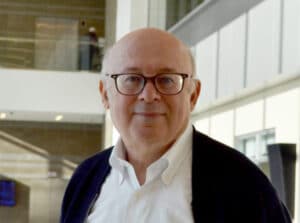Media Archive
Herein lies an archive of all of the videos and podcasts that we have featured on our website.
Herein lies an archive of all of the videos and podcasts that we have featured on our website.
ULYSSES, 100 years on and the spell remains cast. It won’t stop because you’ve stopped…It will just keep on going behind your back. Irish novelists Ann Enright and Eimer McBride in conversation about James Joyce’s Ulysses. “It’s a heavy book…if you’re cycling”. (14 year old Ann). “It would make it all better…it would make Deutsche Bank recede”. (Eimear, at 25)
John Dall’Aglio & Derek Hook discuss John’s work marrying Lacanian psychoanalysis with neuroscience. Refreshing attempt to develop a new conceptual space within Lacanian psychoanalysis. Influenced by Slavoj Zizek and Adrian Johnston. He’s not glossing over the inevitable friction points. [Don’t the best of marriages survive and flourish within those, anyway?] Tongue in cheek, he points out that Lacan was not immune to neuroscience, even though Lacanianism might be allergic! Watch out for Irish psychoanalyst Paul Moore getting namechecked for his psychoanalytic work with the seriously neurologically compromised.
John and Derek are colleagues at Duquesne University, which hosts the Lacan: Clinic & Culture conference, 14 – 16 October 2022.
Bringing Quietness to the Heart of the Storm
“Physical illness begins a very serious journey where there is a disconnect between one’s sense of embeddedness in one’s own body, to all of a sudden being contained within a persecutory object.”
Listen to this podcast from the IPA- off the couch series. Garvil Hercz M.D. discusses his work introducing psychodynamic psychotherapy into the dialysis unit of the nephrology department of an Ontario hospital. The short-term work produced dramatic results. It’s a great example of the application of psychoanalytic thinking laterally, outside traditional practice.


President of the IPA, Virginia Ungar, talks to reknowned author, Siri Hustvedt, ahead of the IPA’s 52nd Congress. Siri will be the guest speaker during the opening ceremony on Wednesday 21st July.
For anyone with an appreciation of and fascination with the intricacies of memory, and of the symptoms that beset us by times, her novel Memories of the Future and her unique neurological memoir The Shaking Woman or A History of my Nerves, are glorious windows onto those other scenes.
The Case for Psychoanalysis: Exploring the Scientific Evidence
John Thor Cornelius M.D. takes us through the scientific findings on treatment outcomes.
When compared to drug treatments and CBT, findings show that only those who have psychoanalytic treatment continue to improve even when the treatment ends. The gains from CBT and from drug treatment are lost.
Marcus Pound of Durham University expertly taking us through a rough guide to Jacques Lacan. Well worth watching!
A fantastic 5-minute-long animated piece from The School of Life, on Freud’s concept of Sublimation.
Short and to the point.
LISTEN HERE TO OUR FLi COURSE DIRECTOR DR EVE WATSON SPEAKING ABOUT PSYCHOANALYSIS.
A psychoanalyst talking openly and frankly about her family, life and her own experience of psychoanalysis, about what drew her to it and what she drew from it..
Anouchka Grose, psychoanalyst and author, talks with Ajay Khandelwal about her life, training and working as a psychoanalyst.
Adam Phillips Thinking Aloud:
At a time when happiness is almost obligatory and disatisfaction is decried, a psychoanalyst asks the question:
Must we really always be enjoying ourselves?
JULIET MITCHELL is a psychoanalyst who was an early commentator on the work of Jacques Lacan.
Here she speaks about war and warfare. Tongue in cheek, she speaks of the Law of the Mother, the Covenant between the mother and the child, under (and over and above?) the Law of the Father.
Watch “Darian Leader on (the marketing of) depression” PART ONE
Watch “Darian Leader on (the marketing of) depression” PART TWO